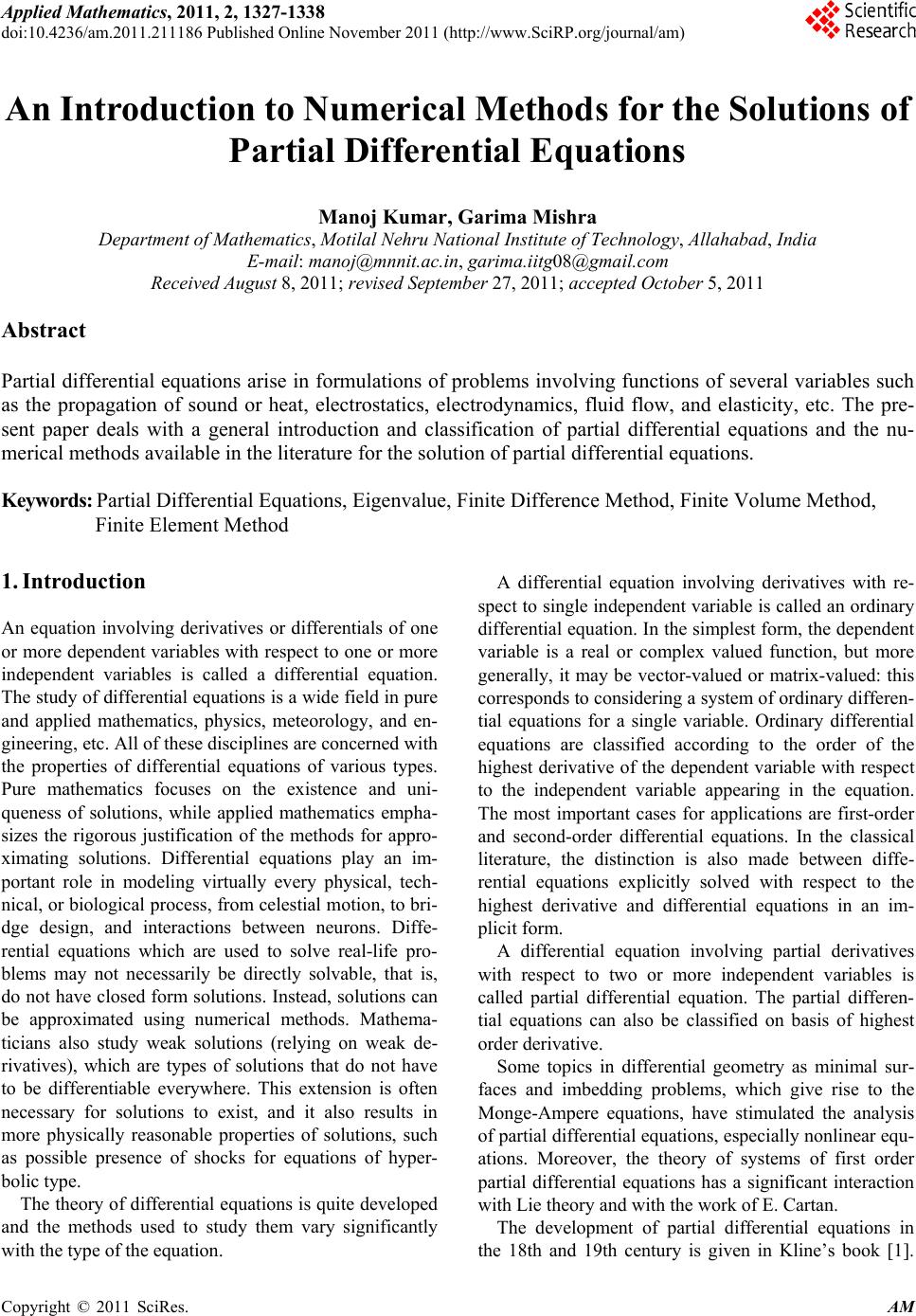 Applied Mathematics, 2011, 2, 1327-1338 doi:10.4236/am.2011.211186 Published Online November 2011 (http://www.SciRP.org/journal/am) Copyright © 2011 SciRes. AM An Introduction to Numerical Methods for the Solutions of Partial Differential Equations Manoj Kumar, Garima Mishra Department of Mat hematics, Motilal Nehru National Institute of Technology, Allahabad, India E-mail: manoj@mnnit.ac.in, garima.iitg08@gmail.com Received August 8, 2011; revised September 27, 2011; accepted October 5, 2011 Abstract Partial differential equations arise in formulations of problems involving functions of several variables such as the propagation of sound or heat, electrostatics, electrodynamics, fluid flow, and elasticity, etc. The pre- sent paper deals with a general introduction and classification of partial differential equations and the nu- merical methods available in the literature for the solution of partial differential equations. Keywords: Partial Differential Equations, Eigenvalue, Finite Difference Method, Finite Volume Method, Finite Element Method 1. Introduction An equation involving derivatives or differentials of one or more dependent variables with respect to one or more independent variables is called a differential equation. The study of differential equations is a wide field in pure and applied mathematics, physics, meteorology, and en- gineering, etc. All of these disciplines are concerned with the properties of differential equations of various types. Pure mathematics focuses on the existence and uni- queness of solutions, while applied mathematics empha- sizes the rigorous justification of the methods for appro- ximating solutions. Differential equations play an im- portant role in modeling virtually every physical, tech- nical, or biological process, from celestial motion, to bri- dge design, and interactions between neurons. Diffe- rential equations which are used to solve real-life pro- blems may not necessarily be directly solvable, that is, do not have closed form solutions. Instead, solutions can be approximated using numerical methods. Mathema- ticians also study weak solutions (relying on weak de- rivatives), which are types of solutions that do not have to be differentiable everywhere. This extension is often necessary for solutions to exist, and it also results in more physically reasonable properties of solutions, such as possible presence of shocks for equations of hyper- bolic type. The theory of differential equations is quite developed and the methods used to study them vary significantly with the type of the equation. A differential equation involving derivatives with re- spect to single independent variable is called an ordinary differential equation. In the simplest form, the dependent variable is a real or complex valued function, but more generally, it may be vector-valued or matrix-valued: this corresponds to considering a system of ordinary differen- tial equations for a single variable. Ordinary differential equations are classified according to the order of the highest derivative of the dependent variable with respect to the independent variable appearing in the equation. The most important cases for applications are first-order and second-order differential equations. In the classical literature, the distinction is also made between diffe- rential equations explicitly solved with respect to the highest derivative and differential equations in an im- plicit form. A differential equation involving partial derivatives with respect to two or more independent variables is called partial differential equation. The partial differen- tial equations can also be classified on basis of highest order derivative. Some topics in differential geometry as minimal sur- faces and imbedding problems, which give rise to the Monge-Ampere equations, have stimulated the analysis of partial differential equations, especially nonlinear equ- ations. Moreover, the theory of systems of first order partial differential equations has a significant interaction with Lie theory and with the work of E. Cartan. The development of partial differential equations in the 18th and 19th century is given in Kline’s book [1]. 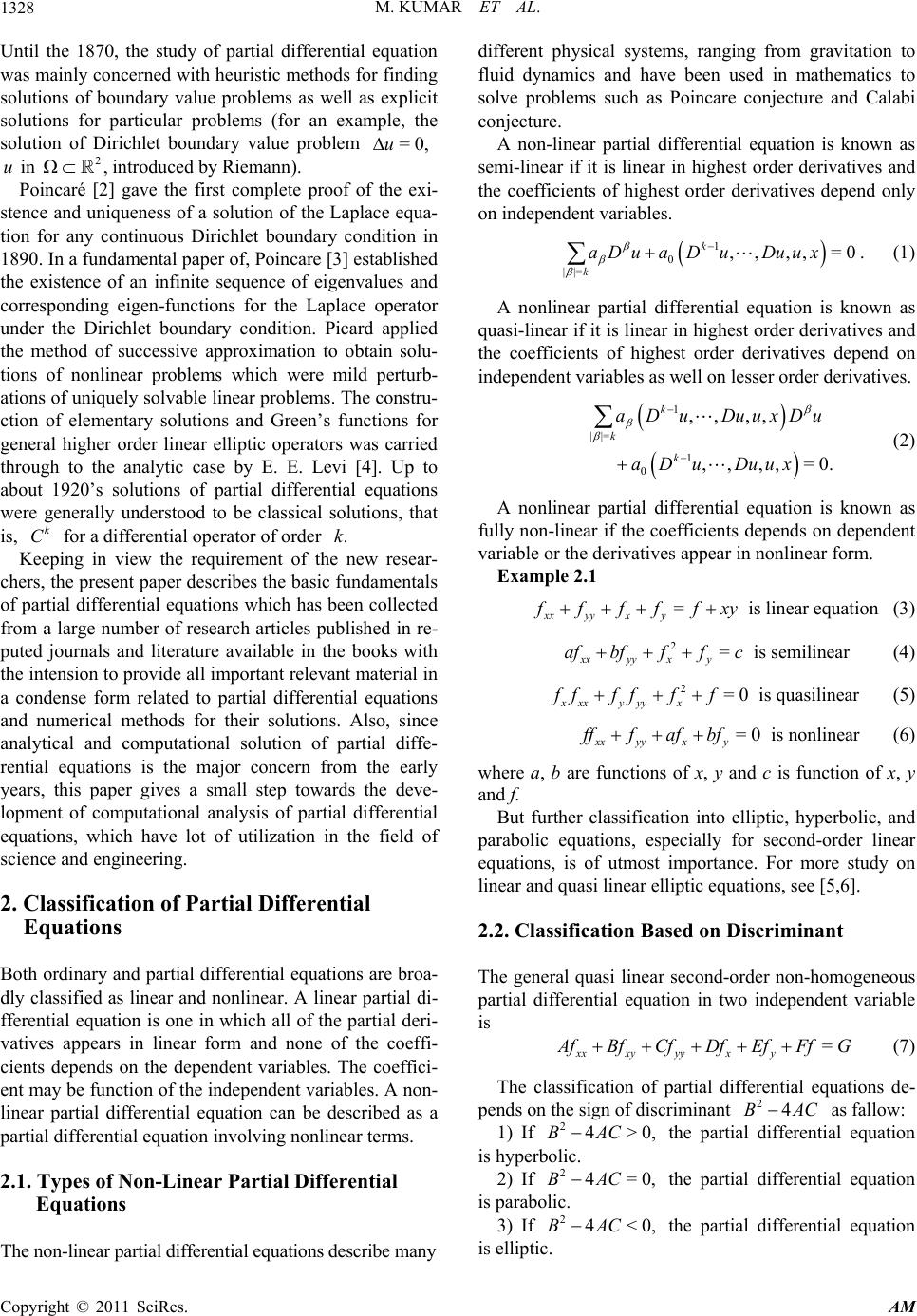 M. KUMAR ET AL. 1328 Until the 1870, the study of partial differential equation was mainly concerned with heuristic methods for finding solutions of boundary value problems as well as explicit solutions for particular problems (for an example, the solution of Dirichlet boundary value problem =0, u introduced by Riemann). 2 in ,u Poincaré [2] gave the first complete proof of the exi- stence and uniqueness of a solution of the Laplace equa- tion for any continuous Dirichlet boundary condition in 1890. In a fundamental paper of, Poincare [3] established the existence of an infinite sequence of eigenvalues and corresponding eigen-functions for the Laplace operator under the Dirichlet boundary condition. Picard applied the method of successive approximation to obtain solu- tions of nonlinear problems which were mild perturb- ations of uniquely solvable linear problems. The constru- ction of elementary solutions and Green’s functions for general higher order linear elliptic operators was carried through to the analytic case by E. E. Levi [4]. Up to about 1920’s solutions of partial differential equations were generally understood to be classical solutions, that is, for a differential operator of order k C.k Keeping in view the requirement of the new resear- chers, the present paper describes the basic fundamentals of partial differential equations which has been collected from a large number of research articles published in re- puted journals and literature available in the books with the intension to provide all important relevant material in a condense form related to partial differential equations and numerical methods for their solutions. Also, since analytical and computational solution of partial diffe- rential equations is the major concern from the early years, this paper gives a small step towards the deve- lopment of computational analysis of partial differential equations, which have lot of utilization in the field of science and engineering. 2. Classification of Partial Differential Equations Both ordinary and partial differential equations are broa- dly classified as linear and nonlinear. A linear partial di- fferential equation is one in which all of the partial deri- vatives appears in linear form and none of the coeffi- cients depends on the dependent variables. The coeffici- ent may be function of the independent variables. A non- linear partial differential equation can be described as a partial differential equation involving nonlinear terms. 2.1. Types of Non-Linear Partial Differential Equations The non-linear partial differential equations describe many different physical systems, ranging from gravitation to fluid dynamics and have been used in mathematics to solve problems such as Poincare conjecture and Calabi conjecture. A non-linear partial differential equation is known as semi-linear if it is linear in highest order derivatives and the coefficients of highest order derivatives depend only on independent variables. 1 0 ||= ,,,, =0 k k aDuaDu Duux . (1) A nonlinear partial differential equation is known as quasi-linear if it is linear in highest order derivatives and the coefficients of highest order derivatives depend on independent variables as well on lesser order derivatives. 1 ||= 1 0 ,, ,, ,,,, =0 k k k aDu DuuxDu aDu Duux . (2) A nonlinear partial differential equation is known as fully non-linear if the coefficients depends on dependent variable or the derivatives appear in nonlinear form. Example 2.1 = is linear equation xx yy x y fffffxy (3) 2= is semilinear xxyy xy afbfff c (4) 2= 0 is quasilinear xxxyyy x ffffff (5) = 0 is nonlinear xx yyxy fffaf bf (6) where a, b are functions of x, y and c is function of x, y and f. But further classification into elliptic, hyperbolic, and parabolic equations, especially for second-order linear equations, is of utmost importance. For more study on linear and quasi linear elliptic equations, see [5,6]. 2.2. Classification Based on Discriminant The general quasi linear second-order non-homogeneous partial differential equation in two independent variable is = xx xyyyxy fBfCfDfEfFfG (7) The classification of partial differential equations de- pends on the sign of discriminant as fallow: 24BAC , , , 1) If the partial differential equation is hyperbolic. 24>0BAC 2) If the partial differential equation is parabolic. 24=0BAC 3) If the partial differential equation is elliptic. 24<0BAC Copyright © 2011 SciRes. AM 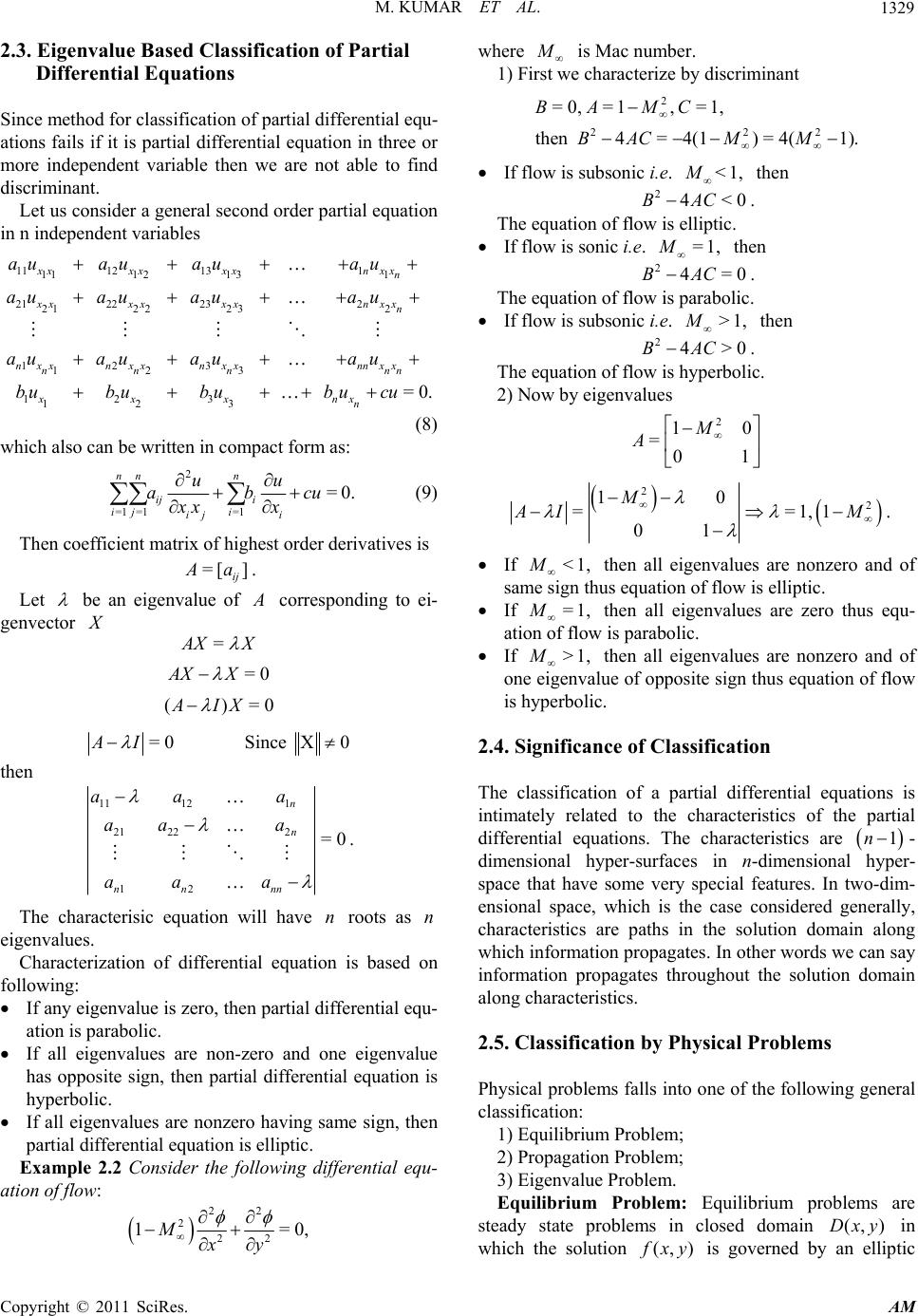 M. KUMAR ET AL.1329 n 2.3. Eigenvalue Based Classification of Partial Differential Equations Since method for classification of partial differential equ- ations fails if it is partial differential equation in three or more independent variable then we are not able to find discriminant. Let us consider a general second order partial equation in n independent variables 11 12131 11 12131 21 22232 21 22232 12 3 123 12 3 123 =0. xxxxxxn xx n xxxxxxn xx n nxxn xxnxxnnxx nnn n xxx nx n au auauau au auauau auauauau bubububu cu (8) which also can be written in compact form as: 2 =1 =1=1 = 0. nn n ij i ij i ij i uu abcu xx x (9) Then coefficient matrix of highest order derivatives is =[ ] ij a. Let be an eigenvalue of corresponding to ei- genvector = XX =0AX X ()=AIX0 = 0 Since X0AI then 11 121 21 222 12 =0 n n nn nn aa a aa a aa a . The characterisic equation will have roots as n eigenvalues. n Characterization of differential equation is based on following: If any eigenvalue is zero, then partial differential equ- ation is parabolic. If all eigenvalues are non-zero and one eigenvalue has opposite sign, then partial differential equation is hyperbolic. If all eigenvalues are nonzero having same sign, then partial differential equation is elliptic. Example 2.2 Consider the following differential equ- ation of flow: 22 2 22 1=Mxy where is Mac number. 1) First we characterize by discriminant 2 22 =0, =1, =1, then 4=4(1) = 4(1). BAMC BACMM 2 If flow is subsonic i.e. <1,M then 24<BAC0 0 0 . The equation of flow is elliptic. If flow is sonic i.e. =1,M then 24=BAC. The equation of flow is parabolic. If flow is subsonic i.e. >1,M then 24>BAC. The equation of flow is hyperbolic. 2) Now by eigenvalues 2 10 =01 M A 2 2 10 == 01 1,1 M AI M . If <1,M then all eigenvalues are nonzero and of same sign thus equation of flow is elliptic. If =1,M then all eigenvalues are zero thus equ- ation of flow is parabolic. If >1,M then all eigenvalues are nonzero and of one eigenvalue of opposite sign thus equation of flow is hyperbolic. 2.4. Significance of Classification The classification of a partial differential equations is intimately related to the characteristics of the partial differential equations. The characteristics are 1n - dimensional hyper-surfaces in n-dimensional hyper- space that have some very special features. In two-dim- ensional space, which is the case considered generally, characteristics are paths in the solution domain along which information propagates. In other words we can say information propagates throughout the solution domain along characteristics. 2.5. Classification by Physical Problems Physical problems falls into one of the following general classification: 1) Equilibrium Problem; 2) Propagation Problem; 3) Eigenvalue Problem. Equilibrium Problem: Equilibrium problems are steady state problems in closed domain in which the solution (, )Dxy (, ) xy is governed by an elliptic 0, Copyright © 2011 SciRes. AM 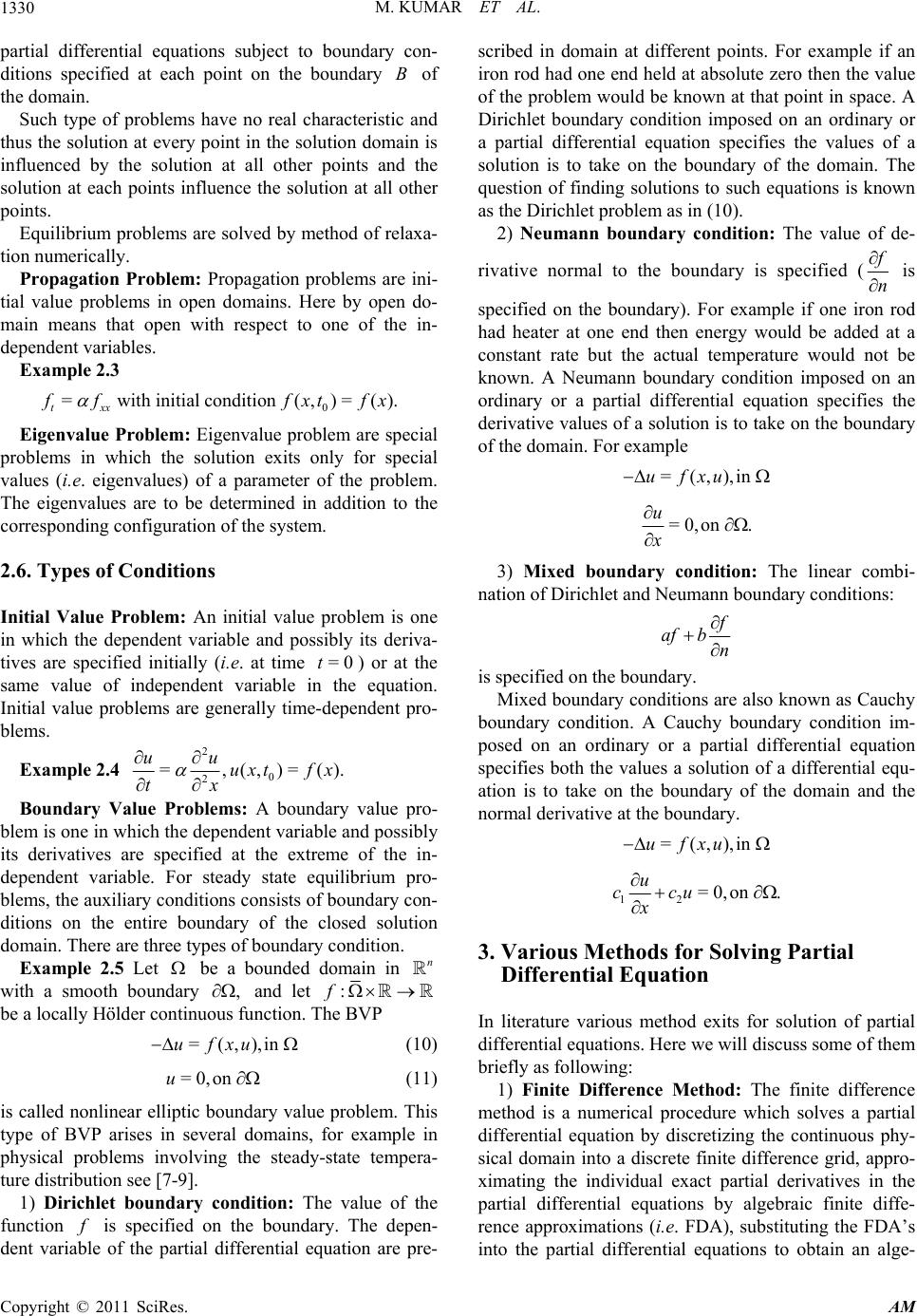 M. KUMAR ET AL. 1330 partial differential equations subject to boundary con- ditions specified at each point on the boundary of the domain. B ). Such type of problems have no real characteristic and thus the solution at every point in the solution domain is influenced by the solution at all other points and the solution at each points influence the solution at all other points. Equilibrium problems are solved by method of relaxa- tion numerically. Propagation Problem: Propagation problems are ini- tial value problems in open domains. Here by open do- main means that open with respect to one of the in- dependent variables. Example 2.3 0 = with initial condition (,) =( txx ffxtfx Eigenvalue Problem: Eigenvalue problem are special problems in which the solution exits only for special values (i.e. eigenvalues) of a parameter of the problem. The eigenvalues are to be determined in addition to the corresponding configuration of the system. 2.6. Types of Conditions Initial Value Problem: An initial value problem is one in which the dependent variable and possibly its deriva- tives are specified initially (i.e. at time ) or at the same value of independent variable in the equation. Initial value problems are generally time-dependent pro- blems. =0t Example 2.4 2 0 2 =, (,)=( uu uxtf x tx ). Boundary Value Problems: A boundary value pro- blem is one in which the dependent variable and possibly its derivatives are specified at the extreme of the in- dependent variable. For steady state equilibrium pro- blems, the auxiliary conditions consists of boundary con- ditions on the entire boundary of the closed solution domain. There are three types of boundary condition. Example 2.5 Let be a bounded domain in with a smooth boundary and let n , :f be a locally Hölder continuous function. The BVP =(,),in ufxu (10) =0,on u (11) is called nonlinear elliptic boundary value problem. This type of BVP arises in several domains, for example in physical problems involving the steady-state tempera- ture distribution see [7-9]. 1) Dirichlet boundary condition: The value of the function is specified on the boundary. The depen- dent variable of the partial differential equation are pre- scribed in domain at different points. For example if an iron rod had one end held at absolute zero then the value of the problem would be known at that point in space. A Dirichlet boundary condition imposed on an ordinary or a partial differential equation specifies the values of a solution is to take on the boundary of the domain. The question of finding solutions to such equations is known as the Dirichlet problem as in (10). f 2) Neumann boundary condition: The value of de- rivative normal to the boundary is specified ( n is specified on the boundary). For example if one iron rod had heater at one end then energy would be added at a constant rate but the actual temperature would not be known. A Neumann boundary condition imposed on an ordinary or a partial differential equation specifies the derivative values of a solution is to take on the boundary of the domain. For example =(,),in ufxu =0,on . u x 3) Mixed boundary condition: The linear combi- nation of Dirichlet and Neumann boundary conditions: afb n is specified on the boundary. Mixed boundary conditions are also known as Cauchy boundary condition. A Cauchy boundary condition im- posed on an ordinary or a partial differential equation specifies both the values a solution of a differential equ- ation is to take on the boundary of the domain and the normal derivative at the boundary. =(,),in ufxu 12 =0,on . u ccu x 3. Various Methods for Solving Partial Differential Equation In literature various method exits for solution of partial differential equations. Here we will discuss some of them briefly as following: 1) Finite Difference Method: The finite difference method is a numerical procedure which solves a partial differential equation by discretizing the continuous phy- sical domain into a discrete finite difference grid, appro- ximating the individual exact partial derivatives in the partial differential equations by algebraic finite diffe- rence approximations (i.e. FDA), substituting the FDA’s into the partial differential equations to obtain an alge- Copyright © 2011 SciRes. AM 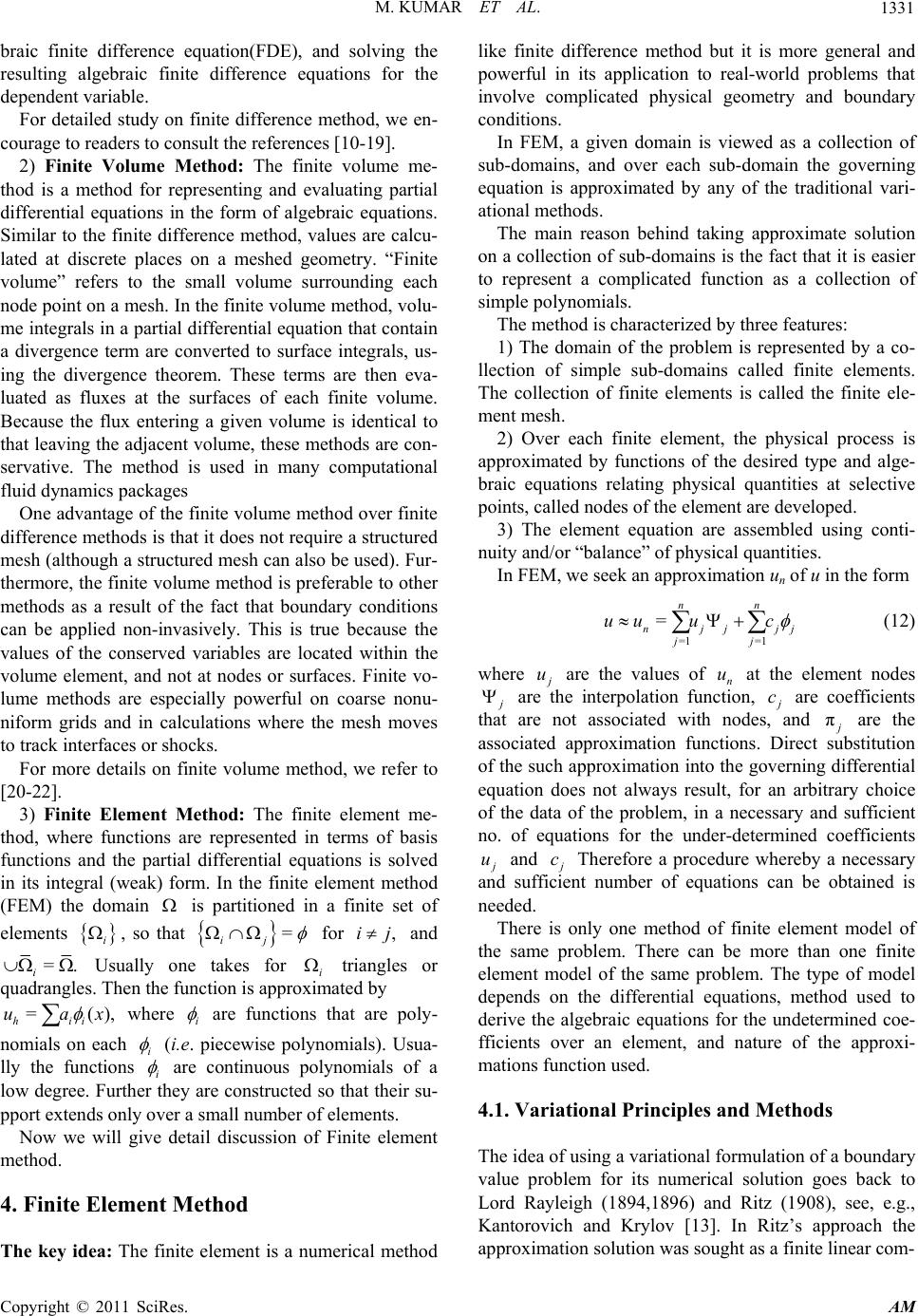 M. KUMAR ET AL.1331 braic finite difference equation(FDE), and solving the resulting algebraic finite difference equations for the dependent variable. For detailed study on finite difference method, we en- courage to readers to consult the references [10-19]. 2) Finite Volume Method: The finite volume me- thod is a method for representing and evaluating partial differential equations in the form of algebraic equations. Similar to the finite difference method, values are calcu- lated at discrete places on a meshed geometry. “Finite volume” refers to the small volume surrounding each node point on a mesh. In the finite volume method, volu- me integrals in a partial differential equation that contain a divergence term are converted to surface integrals, us- ing the divergence theorem. These terms are then eva- luated as fluxes at the surfaces of each finite volume. Because the flux entering a given volume is identical to that leaving the adjacent volume, these methods are con- servative. The method is used in many computational fluid dynamics packages One advantage of the finite volume method over finite difference methods is that it does not require a structured mesh (although a structured mesh can also be used). Fur- thermore, the finite volume method is preferable to other methods as a result of the fact that boundary conditions can be applied non-invasively. This is true because the values of the conserved variables are located within the volume element, and not at nodes or surfaces. Finite vo- lume methods are especially powerful on coarse nonu- niform grids and in calculations where the mesh moves to track interfaces or shocks. For more details on finite volume method, we refer to [20-22]. 3) Finite Element Method: The finite element me- thod, where functions are represented in terms of basis functions and the partial differential equations is solved in its integral (weak) form. In the finite element method (FEM) the domain is partitioned in a finite set of elements , so that i = ij for ,ij and =. i Usually one takes for i triangles or quadrangles. Then the function is approximated by =( hii uax ), where i are functions that are poly- nomials on each i (i.e. piecewise polynomials). Usua- lly the functions i are continuous polynomials of a low degree. Further they are constructed so that their su- pport extends only over a small number of elements. Now we will give detail discussion of Finite element method. 4. Finite Element Method The key idea: The finite element is a numerical method like finite difference method but it is more general and powerful in its application to real-world problems that involve complicated physical geometry and boundary conditions. In FEM, a given domain is viewed as a collection of sub-domains, and over each sub-domain the governing equation is approximated by any of the traditional vari- ational methods. The main reason behind taking approximate solution on a collection of sub-domains is the fact that it is easier to represent a complicated function as a collection of simple polynomials. The method is characterized by three features: 1) The domain of the problem is represented by a co- llection of simple sub-domains called finite elements. The collection of finite elements is called the finite ele- ment mesh. 2) Over each finite element, the physical process is approximated by functions of the desired type and alge- braic equations relating physical quantities at selective points, called nodes of the element are developed. 3) The element equation are assembled using conti- nuity and/or “balance” of physical quantities. In FEM, we seek an approximation un of u in the form =1 =1 = nn njj jj uu uc jj (12) where u are the values of n at the element nodes u are the interpolation function, c are coefficients that are not associated with nodes, and π are the associated approximation functions. Direct substitution of the such approximation into the governing differential equation does not always result, for an arbitrary choice of the data of the problem, in a necessary and sufficient no. of equations for the under-determined coefficients u and c Therefore a procedure whereby a necessary and sufficient number of equations can be obtained is needed. There is only one method of finite element model of the same problem. There can be more than one finite element model of the same problem. The type of model depends on the differential equations, method used to derive the algebraic equations for the undetermined coe- fficients over an element, and nature of the approxi- mations function used. 4.1. Variational Principles and Methods The idea of using a variational formulation of a boundary value problem for its numerical solution goes back to Lord Rayleigh (1894,1896) and Ritz (1908), see, e.g., Kantorovich and Krylov [13]. In Ritz’s approach the approximation solution was sought as a finite linear com- Copyright © 2011 SciRes. AM 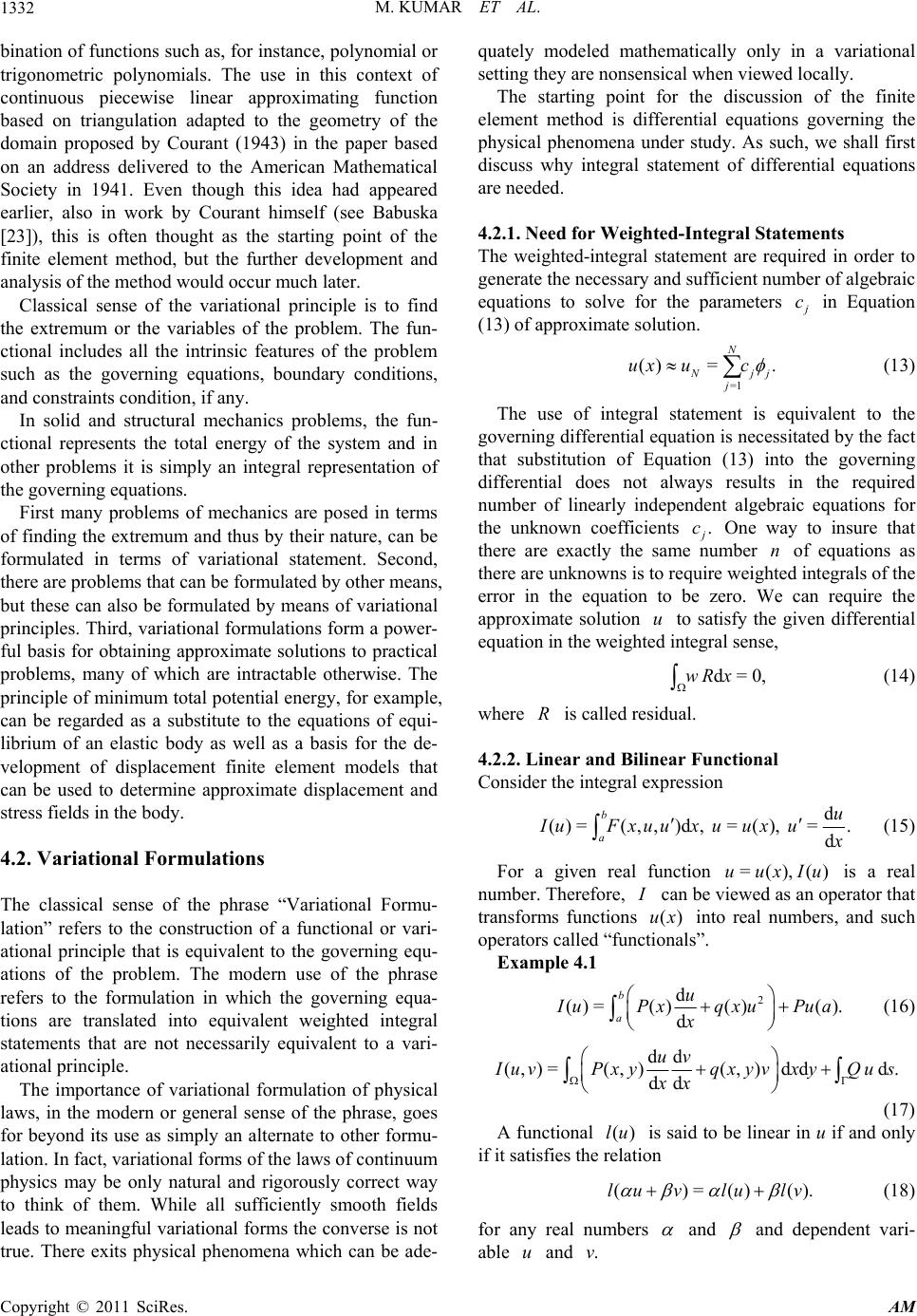 M. KUMAR ET AL. 1332 bination of functions such as, for instance, polynomial or trigonometric polynomials. The use in this context of continuous piecewise linear approximating function based on triangulation adapted to the geometry of the domain proposed by Courant (1943) in the paper based on an address delivered to the American Mathematical Society in 1941. Even though this idea had appeared earlier, also in work by Courant himself (see Babuska [23]), this is often thought as the starting point of the finite element method, but the further development and analysis of the method would occur much later. Classical sense of the variational principle is to find the extremum or the variables of the problem. The fun- ctional includes all the intrinsic features of the problem such as the governing equations, boundary conditions, and constraints condition, if any. In solid and structural mechanics problems, the fun- ctional represents the total energy of the system and in other problems it is simply an integral representation of the governing equations. First many problems of mechanics are posed in terms of finding the extremum and thus by their nature, can be formulated in terms of variational statement. Second, there are problems that can be formulated by other means, but these can also be formulated by means of variational principles. Third, variational formulations form a power- ful basis for obtaining approximate solutions to practical problems, many of which are intractable otherwise. The principle of minimum total potential energy, for example, can be regarded as a substitute to the equations of equi- librium of an elastic body as well as a basis for the de- velopment of displacement finite element models that can be used to determine approximate displacement and stress fields in the body. 4.2. Variational Formulations The classical sense of the phrase “Variational Formu- lation” refers to the construction of a functional or vari- ational principle that is equivalent to the governing equ- ations of the problem. The modern use of the phrase refers to the formulation in which the governing equa- tions are translated into equivalent weighted integral statements that are not necessarily equivalent to a vari- ational principle. The importance of variational formulation of physical laws, in the modern or general sense of the phrase, goes for beyond its use as simply an alternate to other formu- lation. In fact, variational forms of the laws of continuum physics may be only natural and rigorously correct way to think of them. While all sufficiently smooth fields leads to meaningful variational forms the converse is not true. There exits physical phenomena which can be ade- quately modeled mathematically only in a variational setting they are nonsensical when viewed locally. The starting point for the discussion of the finite element method is differential equations governing the physical phenomena under study. As such, we shall first discuss why integral statement of differential equations are needed. 4.2.1. Need for Weighted-Integral Statements The weighted-integral statement are required in order to generate the necessary and sufficient number of algebraic equations to solve for the parameters c in Equation (13) of approximate solution. =1 () =. N jj j ux uc (13) The use of integral statement is equivalent to the governing differential equation is necessitated by the fact that substitution of Equation (13) into the governing differential does not always results in the required number of linearly independent algebraic equations for the unknown coefficients . c One way to insure that there are exactly the same number of equations as there are unknowns is to require weighted integrals of the error in the equation to be zero. We can require the approximate solution to satisfy the given differential equation in the weighted integral sense, n u d=0,wRx (14) where is called residual. R 4.2.2. Linear and Bilinear Functional Consider the integral expression d ()=(,,)d, = (), =. d b a u IuFxuuxuuxu (15) For a given real function is a real number. Therefore, =(), ()uuxIu can be viewed as an operator that transforms functions into real numbers, and such operators called “functionals”. ()ux Example 4.1 2 d ()=()()(). d b a u uPxqxuPu x a (16) dd (,)=(,)(,)dd d. dd uv uvPxyqxyvxyQu s xx (17) A functional is said to be linear in u if and only if it satisfies the relation ()lu ()=()(lu vlu lv). (18) for any real numbers and and dependent vari- able and u.v Copyright © 2011 SciRes. AM 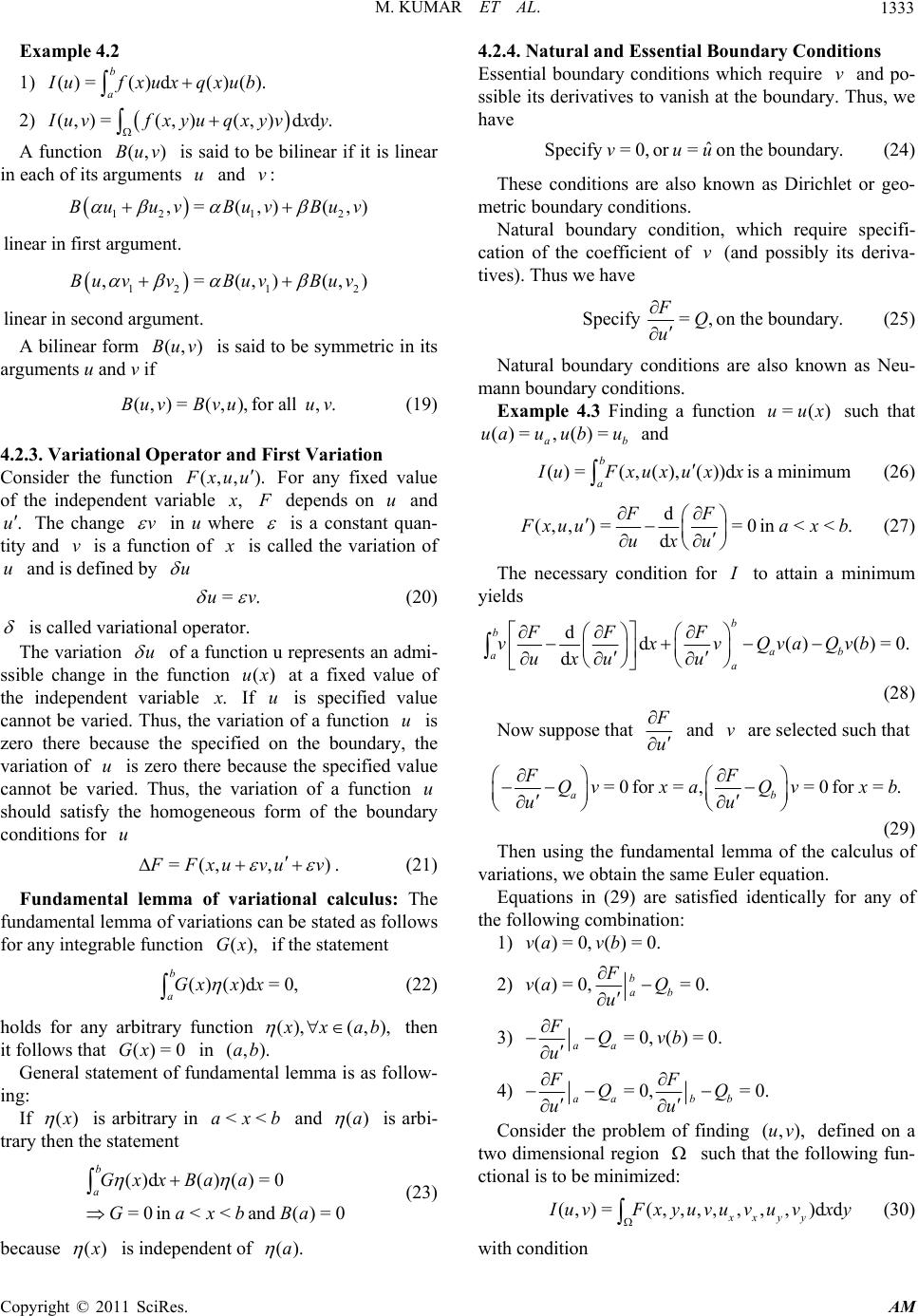 M. KUMAR ET AL.1333 am2 Exple 4. 1) ()= () bd ()(). a uf x ux qxub 2) (,)=(,)(,)dd. uvf xyuqxyvxy unction is said to be bilinear if it is linear in ,) A bilinear form is said to be symmetric in its ar (19) . 2. 3. V ari a tio nal Op erator and First Variation A f(,)Buv rgumen each of its ats u and :v 12 1 ,= (,)Bu uvBu 2 (,)v Buv linear in first argument. 121 2 ,=(,)(Bu vvBuvBuv linear in second argument. (,)Buv f guments u and v i ( , )Buv =(,), for all , .Bvu uv 4 Consider the function (,, ). xuu For any fixed value of the independent variable , depends on u and . u The change v in u wheer is a constantuan- and v is a fution of q tity nc is called the variation of u and isfined by u de u=.v (20) is called variational operator. The variation u of a function u represents an admi- ssible change in t function ()ux at a fixed value of the independent variable . he is specified value cannot be varied. Thus, the riatio of a function u is zero there because the specified on the boundary, the variation of u is zero there because the specified value cannot be vaed. Thus, the variation of a function u should satisfy the homogeneous form of the boundary conditions for u If u nva ri =(, ,) Fxu vuv . (21) Fundamental lemma of variational c fu (22) holds for any arbitrary function alculus: The ndamental lemma of variations can be stated as follows for any integrable function (),Gx if the statement b()()d =0, aGxx x (), (,), xab . tal lemma is as fo then llow- in it follows that ()=0Gx in (,)ab General stateundament of fmen g: If () is arbitrary in and <<axb ()a is arbi- trary the (23) because n the statement ()d b()()=0 =0 in << and ()=0 aGxxBa a GaxbBa () is independent of ().a turaldar nditions po- (24) These conditions are also known as Dirichle m on, which require specifi- ca 4.2.4. Na and Essential Bouny Co Essential boundary conditions which require v and ssible its derivatives to vanish at the boundary. Thus, we have ˆ Specify = 0, or = on the boundary.vuu t or geo- etric boundary conditions. Natural boundary conditi tion of the coefficient of v (and possibly its deriva- tives). Thus we have Specify =, on the boundary. FQ u (25) Natural boundary conditions are also known as Neu- m nction such that (26) ann boundary conditions. Example 4.3 Finding a fu=()uux ()=, ()= ab au ubu and u ()=(,(),())d is a minimum b a IuFxux u xx d (,,)==0 in <<. d FF xuuax b uxu (27) The necessary condition for to attain a minimum yields dd() d b b ab aa ()=0. F F vxvQvaQvb uxu u (28) Now suppose that F u and v are selected such that =0 for =,=0 for =. ab FF Qvxa Qv xb uu (29) Then using the fundamental lemma of the calcu va y of th 2) lus of riations, we obtain the same Euler equation. Equations in (29) are satisfied identically for an e following combination: 1) ()=0, ()=0.va vb ()=0, =0. b ab F va Q u 3) =0, ()=0. aa FQvb u 4) =0, =0. aa bb FF QQ uu nsider the problem of finding defined on a tw Co (,),uv o dimensional region such that thollowing fun- ctional is to be minimized (,)=(, ,, e f : , ,,,)dd xxyy uv Fxyu vu v uvxy (30) with condition Copyright © 2011 SciRes. AM 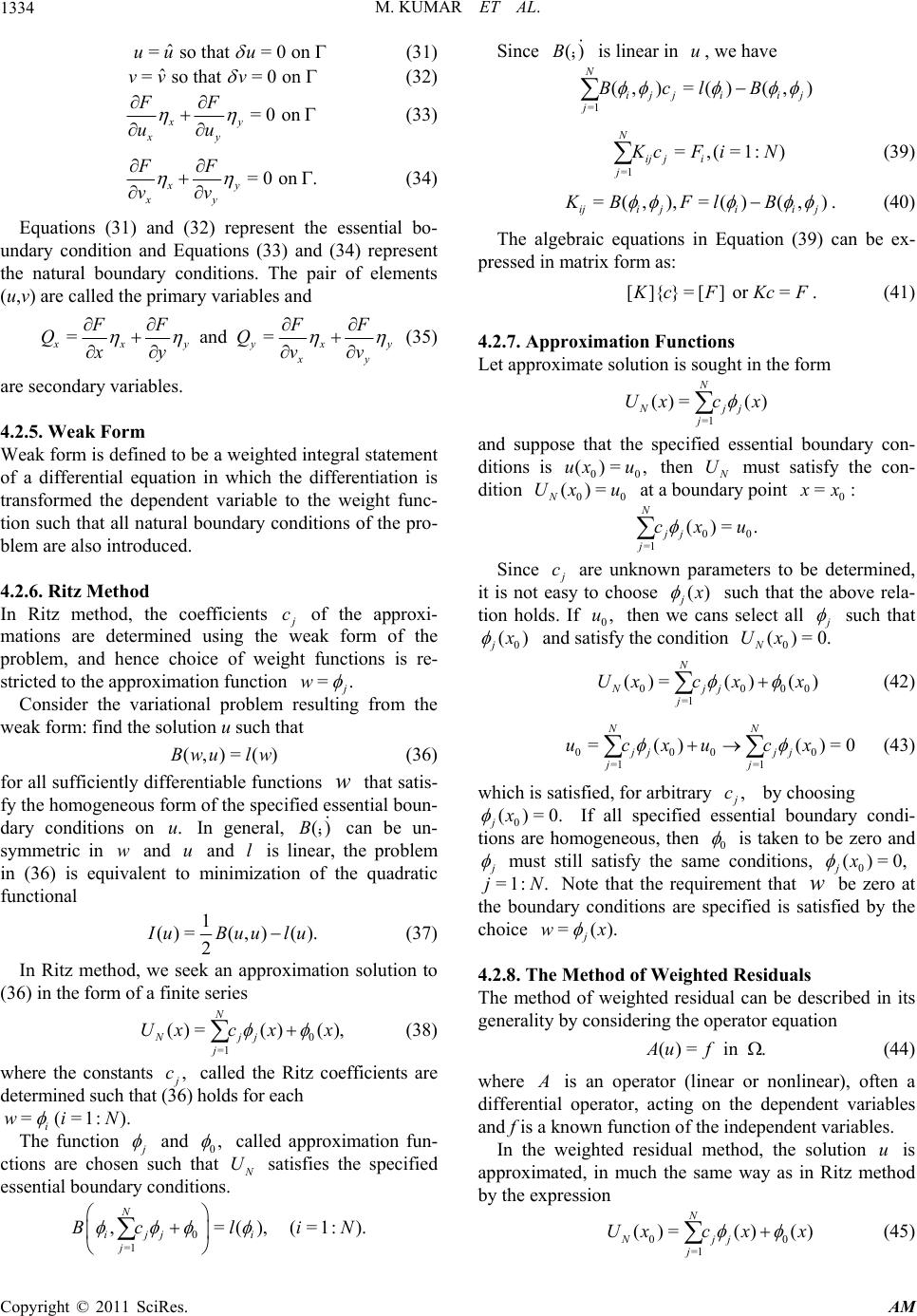 M. KUMAR ET AL. 1334 ˆ = so that =0 on uu u (31) ˆ = so that =0 on vv v (32) = 0on xy xy FF uu (33) =0on . xy xy FF vv (34) Equations (31) and (32) represent the essential bo- undary condition and Equations (33) and (34) represent the natural boundary conditions. The pair of elements (u,v) are called the primary variables and = and = xy yx xy y F QQ xyv v FFF (35) are secondary variables. .2.5. Weak Form d to be a weighted integral statement .2.6. Ritz Method e coefficients 4 Weak form is define of a differential equation in which the differentiation is transformed the dependent variable to the weight func- tion such that all natural boundary conditions of the pro- blem are also introduced. 4 In Ritz method, th c w of the approxi- mations are determined using the eak form of the problem, and hence choice of weight functions is re- stricted to the approximation function =. w Consider the variational problem resulting from the w (36) for all sufficiently differentiable fun v i eak form: find the solution u such that (,)=()Bwu lw ctions w that satis- fy the homogeneous form of the specified essential boun- dary conditions on .u In general, (,)B can be un- symmetric in w and and l is li the problem in (36) is equi alent to minimzation of the quadratic functional unear, 1 ()=(,) (). 2 uBuulu (37) In Ritz method, we seek an approxima (3 (38) where the constants tion solution to 6) in the form of a finite series ()=( N Ux c 0 =1 ) (), Nj j j x x , c called the Ritz coefficients are determined such that (36) holds for each = (=1:). i wiN The function and 0, at called approximation fun- ctions are chosenuch th s U satisfies the specified essential boundary conditions. N 0 =1 ,=(), (=1 ij j i j BcliN :). Since is linear in , we have (, )B N u =1 (, )=()(, ) ijjiij j BclB =1 =,(=1:) N ij ji j cFi N (39) =(,),=()( iji ji KBFlB,) i j . (40) The algebraic equations in Equation (39) can be ex- pressed in matrix form as: []{}=[] or = cFKcF. (41) 4.2.7. Appro ximation Functions Let approximate solution is sought in the fo ed ary con- ditions is then rm =1 j and suppose that the specifi essential bound ()= Nj j Ux c () Nx 00 ()=,uxu U undary mu satisfy the con- dition a bo point st 00N0 ()=Ux u at=: x 00 =1 ( . N jj j cxu Since )= c t easy are unk be determined, it is no to choose nown parameters to () j we cans suchhat the above rela- tion holf then select all t ds. I0,u such that 0 () j and satisfy the condition 0 ()=0. N Ux 0000 =1 ()=() () N Njj j xcxx (42) U 000 0 =1 =1 =() () NN jj jj jj ucxu cx =0 (43) , c by choosing which is satisfied, for arbitrary 0 ()=0. jx If all specified etial boundary ssen 0 condi- tions are homogeneous, then is taken to be zero and must still satisfy the same conditions, 0 ()=0, jx =1: .jN Note that the requirement that w be zero at the boundary conditions are specified is satisfied by the ice =(). j wx cho 4.2.8. The Method of Weighted Residuals The meighthod of weted residual can be described in its on generality by considering the operator equati ()= in .Au f (44) where is an operator (linear or nonlinear), often a differential operator, acting on the d f a k ependent variables and isnown function of the independent variables. In the weighted residual method, the solution u is approximated, in much the same way as in Ritz method by the expression 00 ()=() () N Njj Uxcxx (45) =1 j Copyright © 2011 SciRes. AM 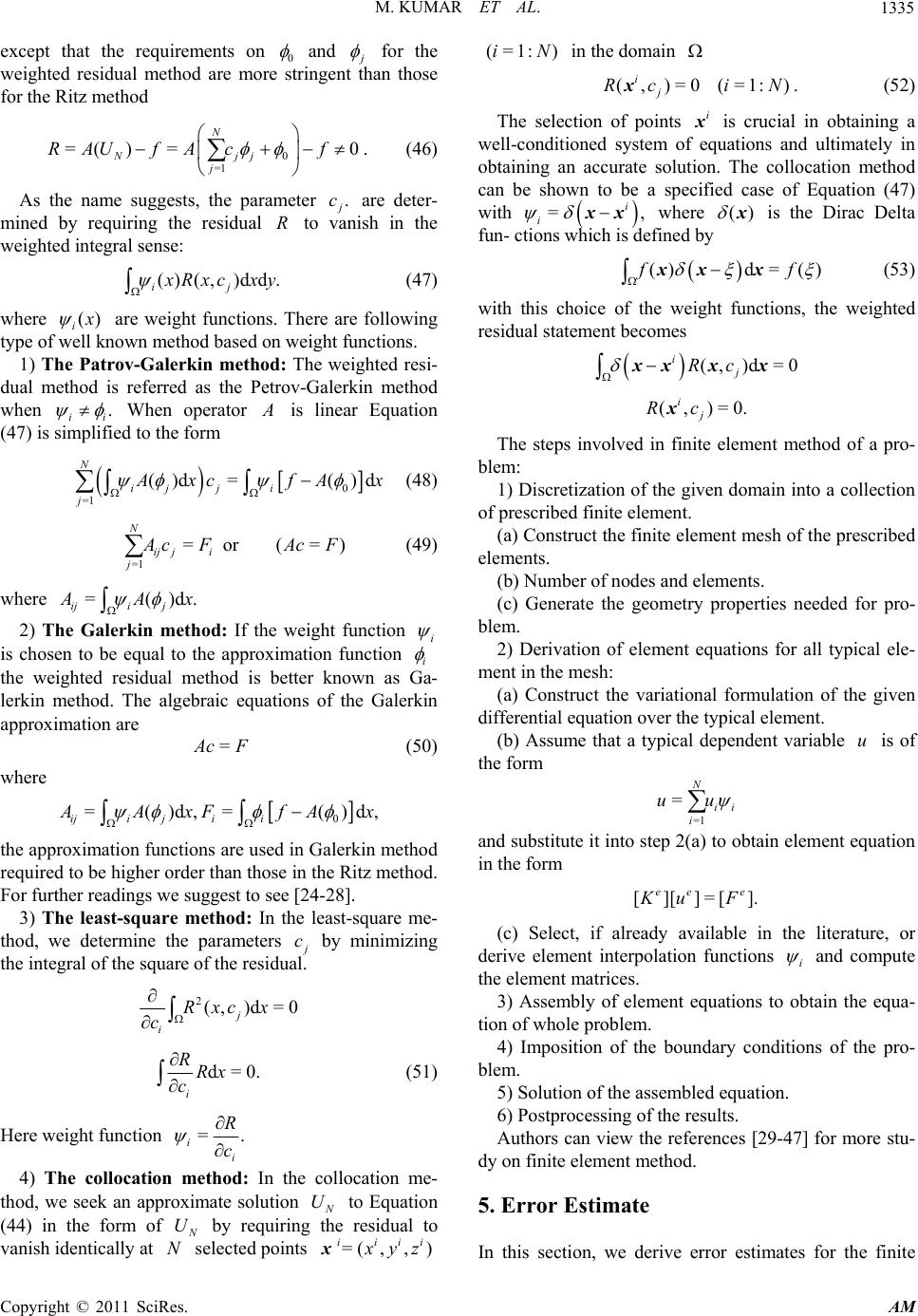 M. KUMAR ET AL.1335 uirements on except that the req0 and for the weighted residual method are monge for the Ritz method As the name suggests, the parameter re strint than those 0 =1 =( )=0 N Njj j RAUf Acf . (46) . c vani are deter- mined by requiring the residual to weighted integral sense: Rsh in the () (,)dd. ij Rxcxy (47) where () i are weight functionshere are following type of well known method . T based on weight functions. 1) The Patrov-Galerkin method ethod : The weighted resi- dual mis referred as the Petrov-Galerkin method when . ii When operator is linear Equation (47) is simplified to the form 0 =1 ()d=()d N ijj ji xcfAx (48) =1 = or (=) N ij ji j cF AcF where . (49) =()d iji j Ax 2) The Galerkin method: If the weight function i is chosen to be equal to the approximation function i - the weethighted residual mod is better known as Ga leinrkin method. The algebraic equations of the Galerk approximation are = cF (50) where 0, i =( iji )d, =()d j i A xF fA x the app required roximation functions are used in Galerkin method to be higher order than those in the Ritz method. For further readings we suggest to see [24-28]. 3) The least-square method: In the least-square me- thod, we determine the parameters c by minimizing the integral of the square of the residual. 2(,)d=0 j i Rxcx c d=0. i RRx c (51) Here weight function =. ii R c 4) The collocation method: In the collocation me- ate solution thod, we seek an approxim U to Equation (44) in the form of U Nby quirinsidual to vanish identically at selected points reg the re =(,,) iiii yz x (=1:)iN in the domain (,)=0 (=1:) i Rci Nx. (52) The selection of points i x is crucial a j in obtaining well-condi tions and ultimately in obtaining an accurate son. The col can be shown to be a spfied case o w tioned system ofqua e lutio eci location method f Equation (47) ith =, i i xx wher()e x is the Dirac Delta fun- ctions which is defined by ()d=()ff xx x (53) with he weighctions, the weighted residual statement becomes this choice of tt fun (,)d =0 ij Rc xxxx (,)=0. ij Rcx The steps involved in finite element method of a pro- blem: 1) Discretization of the given domain into a collection of prescribed finite element. ts. properties needed for pro- bl ion of element equations for all typical ele- m ial equation over the typical element. (a) Construct the finite element mesh of the prescribed elemen (b) Number of nodes and elements. (c) Generate the geometry em. 2) Derivat ent in the mesh: (a) Construct the variational formulation of the given different (b) Assume that a typical dependent variable u is of the form =1 = N ii i uu and substitute it into step 2(a) to obtain element equation in the form .[][]=[] eee uF (c) Select, if already available in the literature, or derive element interpolation functions i and compute the element matrices. 3) Assembly of element equations to obtain the equa- tio e results. ite element method. 5. In this section, we derive error estimates for the finite n of whole problem. 4) Imposition of the boundary conditions of the pro- blem. 5) Solution of the assembled equation. 6) Postprocessing of th Authors can view the references [29-47] for more stu- dy on fin Error Estimate Copyright © 2011 SciRes. AM 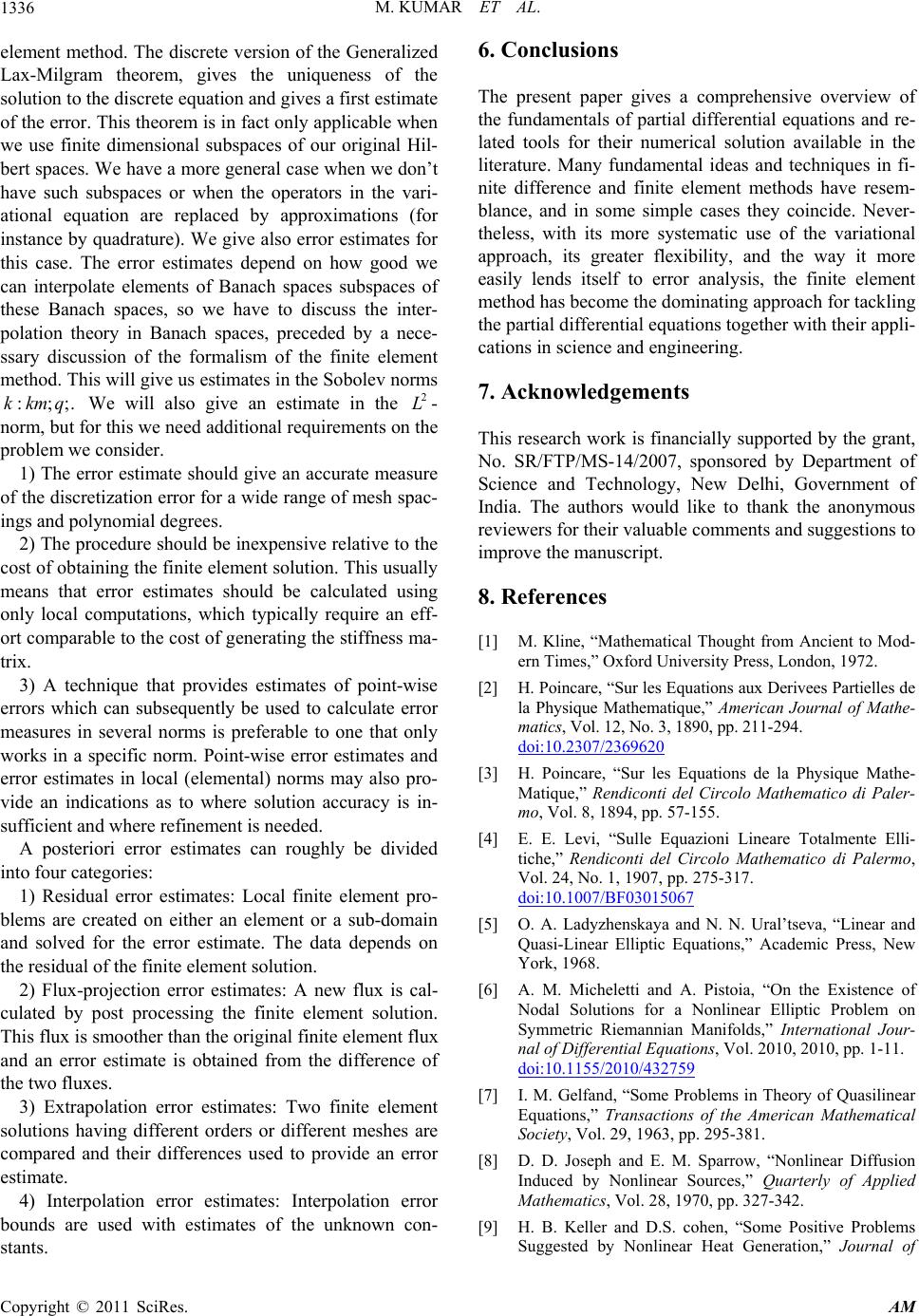 M. KUMAR ET AL. 1336 ersion of the Generalized , gives the uniqueness of the quation and gives a first estimate f the error. This theorem is in fact only applicable when ings and p e element solution. This usually m nerating the stiffness ma- tri timates in local (elemental) norms may also pro- vi depend th error estimates: A new flux is cal- cu n error estimates: Interpolation error bo Th ols for their numerical solution available in the damental ideas and techniques in fi- ite difference and finite element methods have resem- d by Department of cience and Technology, New Delhi, Government of e to thank the anonymous viewers for their valuable comments and suggestions to aux Derivees Partielles de athematique,” American Journal of Mathe- , No. 3, 1890, pp. 211-294. element method. The discrete v Lax-Milgram theorem solution to the discrete e o we use finite dimensional subspaces of our original Hil- bert spaces. We have a more general case when we don’t have such subspaces or when the operators in the vari- ational equation are replaced by approximations (for instance by quadrature). We give also error estimates for this case. The error estimates depend on how good we can interpolate elements of Banach spaces subspaces of these Banach spaces, so we have to discuss the inter- polation theory in Banach spaces, preceded by a nece- ssary discussion of the formalism of the finite element method. This will give us estimates in the Sobolev norms :;;.kkmq We will also give an estimate in the 2 L- norm, but for this we need additional requirements on the problem we consider. 1) The error estimate should give an accurate measure of the discretization error for a wide range of mesh spac- olynomial degrees. 2) The procedure should be inexpensive relative to the cost of obtaining the finit eans that error estimates should be calculated using only local computations, which typically require an eff- ort comparable to the cost of ge x. 3) A technique that provides estimates of point-wise errors which can subsequently be used to calculate error measures in several norms is preferable to one that only works in a specific norm. Point-wise error estimates and error es de an indications as to where solution accuracy is in- sufficient and where refinement is needed. A posteriori error estimates can roughly be divided into four categories: 1) Residual error estimates: Local finite element pro- blems are created on either an element or a sub-domain and solved for the error estimate. The datas on e residual of the finite element solution. 2) Flux-projection lated by post processing the finite element solution. This flux is smoother than the original finite element flux and an error estimate is obtained from the difference of the two fluxes. 3) Extrapolation error estimates: Two finite element solutions having different orders or different meshes are compared and their differences used to provide an error estimate. 4) Interpolatio unds are used with estimates of the unknown con- stants. 6. Conclusions e present paper gives a comprehensive overview of the fundamentals of partial differential equations and re- lated to literature. Many fun n blance, and in some simple cases they coincide. Never- theless, with its more systematic use of the variational approach, its greater flexibility, and the way it more easily lends itself to error analysis, the finite element method has become the dominating approach for tackling the partial differential equations together with their appli- cations in science and engineering. 7. Acknowledgements This research work is financially supported by the grant, No. SR/FTP/MS-14/2007, sponsore S India. The authors would lik re improve the manuscript. 8. References [1] M. Kline, “Mathematical Thought from Ancient to Mod- ern Times,” Oxford University Press, London, 1972. ]H. Poincare, “Sur les Equations[2 la Physique M matics, Vol. 12 doi:10.2307/2369620 [3] H. Poincare, “Sur les Equations de la Physique Mathe- , Matique,” Rendiconti del Circolo Mathematico di Paler- mo, Vol. 8, 1894, pp. 57-155. [4] E. E. Levi, “Sulle Equazioni Lineare Totalmente Elli- tiche,” Rendiconti del Circolo Mathematico di Palermo Vol. 24, No. 1, 1907, pp. 275-317. doi:10.1007/BF03015067 [5] O. A. Ladyzhenskaya and N. N. Ural’tseva, “Linear and Quasi-Linear Elliptic Equations,” Academic Press, New York, 1968. [6] A. M. Micheletti and A. Pistoia, “On the Existence of Nodal Solutions for a Nonlinear Elliptic Problem on Symmetric Riemannian Manifolds,” International Jour- nal of Differential Equations, Vol. 2010, 2010, pp. 1-11. doi:10.1155/2010/432759 [7] I. M. Gelfand, “Some Problems in Theory of Quasilinear Equations,” Transactions of the American Mathematical Society, Vol. 29, 1963, pp. 295-381. [8] D. D. Joseph and E. M. Sparrow, “Nonlinear Diffusion Induced by Nonlinear Sources,” Quarterly of Applied Mathematics, Vol. 28, 1970, pp. 327-342. [9] H. B. Keller and D.S. cohen, “Some Positive Problems Suggested by Nonlinear Heat Generation,” Journal of Copyright © 2011 SciRes. AM 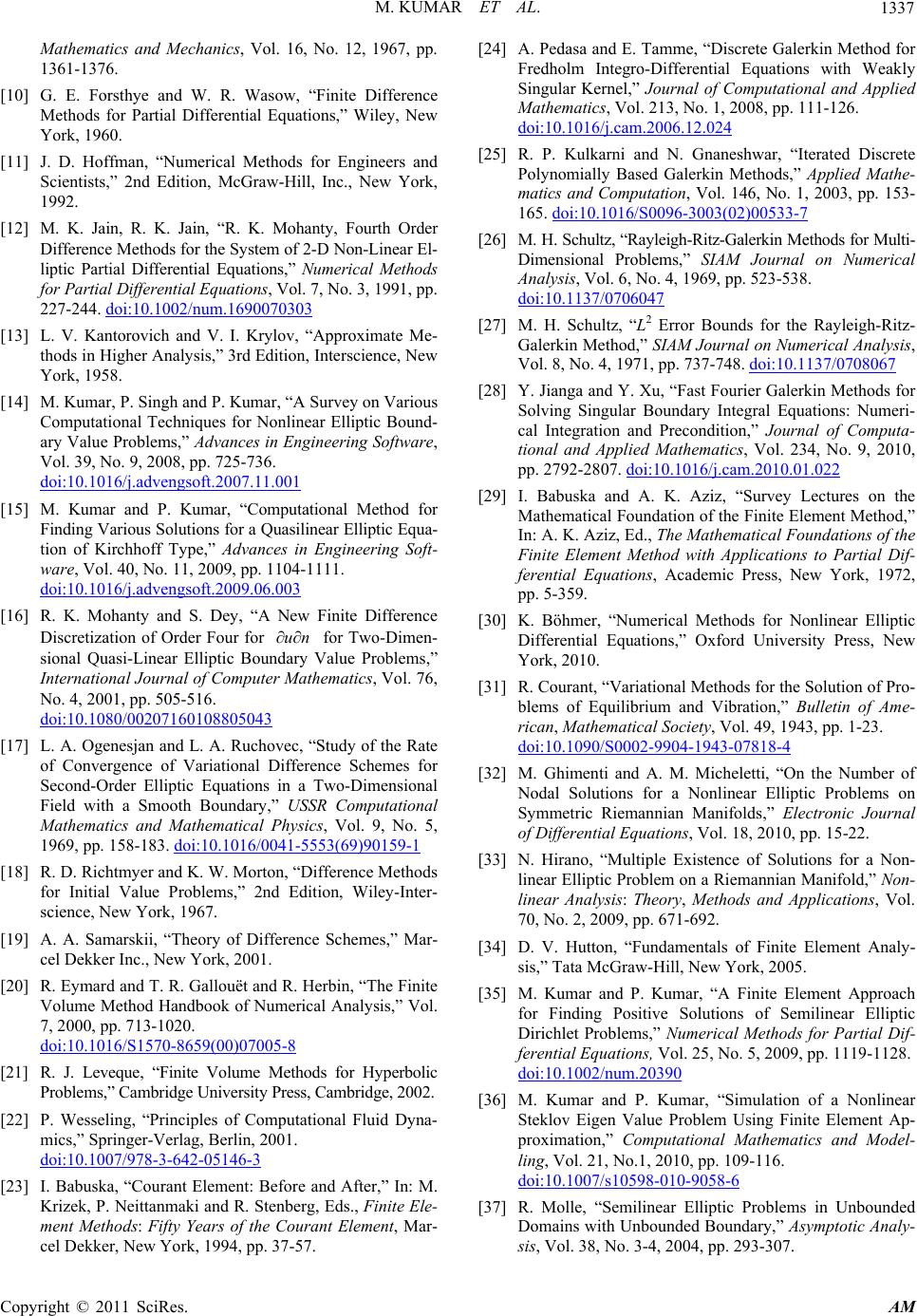 M. KUMAR ET AL.1337 te Difference d Edition, McGraw-Hill, Inc., New York, thods for the System of 2-D Non-Linear El- doi:10.1002/num.1690070303 Mathematics and Mechanics, Vol. 16, No. 12, 1967, pp. 1361-1376. [10] G. E. Forsthye and W. R. Wasow, “Fini Methods for Partial Differential Equations,” Wiley, New York, 1960. [11] J. D. Hoffman, “Numerical Methods for Engineers and Scientists,” 2n 1992. [12] M. K. Jain, R. K. Jain, “R. K. Mohanty, Fourth Order Difference Me liptic Partial Differential Equations,” Numerical Methods for Partial Differential Equations, Vol. 7, No. 3, 1991, pp. 227-244. Elliptic Bound- dvengsoft.2007.11.001 [13] L. V. Kantorovich and V. I. Krylov, “Approximate Me- thods in Higher Analysis,” 3rd Edition, Interscience, New York, 1958. [14] M. Kumar, P. Singh and P. Kumar, “A Survey on Various Computational Techniques for Nonlinear ary Value Problems,” Advances in Engineering Software, Vol. 39, No. 9, 2008, pp. 725-736. doi:10.1016/j.a 4-1111. [15] M. Kumar and P. Kumar, “Computational Method for Finding Various Solutions for a Quasilinear Elliptic Equa- tion of Kirchhoff Type,” Advances in Engineering Soft- ware, Vol. 40, No. 11, 2009, pp. 110 doi:10.1016/j.advengsoft.2009.06.003 [16] R. K. Mohanty and S. Dey, “A New Finite Difference Discretization of Order Four for un for Two-Dimen- sional Quasi-Linear Elliptic Boundary Value Problems,” International Journal of Computer Mathematic No. 4, 2001, pp. 505-516. s, Vol. 76, doi:10.1080/00207160108805043 [17] L. A. Ogenesjan and L. A. Ruchovec, “Study of the Rate of Convergence of Variational Difference Schemes for Second-Order Elliptic Equations in a Two-Dimensional Field with a Smooth Boun Mathematics and Mathematical P dary,” USSR Computational hysics, Vol. 9, No. 5, 1969, pp. 158-183. doi:10.1016/0041-5553(69)90159-1 [18] R. D. Richtmyer and K. W. Morton, “Difference Methods for Initial Value Problems,” 2nd Edition, Wiley-Inter- science, New York, 1967. [19] A. A. Samarskii, “Theory of Difference Schemes,” Mar- cel Dekker Inc., New York, 2001. [20] R. Eymard and T. R. Gallouët and R. Herbin, “The Finite Volume Method Handbook of Numerical Analysis,” Vol. 7, 2000, pp. 713-1020. doi:10.1016/S1570-8659(00)07005-8 [21] R. J. Leveque, “Finite Volume Methods for Hyperbolic Problems,” Cambridge University Press, Cambridge, 2002. [22] P. Wesseling, “Principles of Computational Fluid Dyna- mics,” Springer-Verlag, Berlin, 2001. doi:10.1007/978-3-642-05146-3 [23] I. Babuska, “Courant Element: Before and After,” In: M. Krizek, P. Neittanmaki and R. Stenberg, Eds., Finite Ele- ment Methods: Fifty Years of the Courant Element, Mar- cel Dekker, New York, 1994, pp. 37-57. [24] A. Pedasa and E. Tamme, “Discr ete Galerkin Method for Fredholm Integro-Differential Equations with Weakly Singular Kernel,” Journal of Computational and Applied Mathematics, Vol. 213, No. 1, 2008, pp. 111-126. doi:10.1016/j.cam.2006.12.024 [25] R. P. Kulkarni and N. Gnaneshwar, “Iterated Discrete Polynomially Based Galerkin Methods,” Applied Mathe- matics and Computation, Vol. 146, No. 1, 2003, pp. 153- 165. doi:10.1016/S0096-3003(02)00533-7 [26] M. H. Schultz, “Rayleigh-Ritz-Galerkin Methods for Multi- Dimensional Problems,” SIAM Journal on Numerical Analysis, Vol. 6, No. 4, 1969, pp. 523-538. doi:10.1137/0706047 [27] M. H. Schultz, “L2 Error Bounds for the Rayleigh-Ritz- Galerkin Method,” SIAM Journal on Numerical Analysis, Vol. 8, No. 4, 1971, pp. 737-748. doi:10.1137/0708067 [28] Y. Jianga and Y. Xu, “Fast Fourier Galerkin Solving Singular Bou Methods for ndary Integral Equations: Numeri- cal Integration and Precondition,” Journal of Computa- tional and Applied Mathematics, Vol. 234, No. 9, 2010, pp. 2792-2807. doi:10.1016/j.cam.2010.01.022 [29] I. Babuska and A. K. Aziz, “Survey Lectures on the Mathematical Foundation of the Finite Element Method,” In: A. K. Aziz, Ed., The Mathematical Foundations of the Finite Element Method with Applications to Partial Dif- ferential Equations, Academic Press, New York, 1972, pp. 5-359. [30] K. Böhmer, “Numerical Methods for Nonlinear Elliptic Differential Equations,” Oxford University Press, New York, 2010. [31] R. Courant, “Variational Methods for the Solution of Pro- blems of Equilibrium and Vibration,” Bulletin of Ame- rican, Mathematical Society, Vol. 49, 1943, pp. 1-23. doi:10.1090/S0002-9904-1943-07818-4 [32] M. Ghimenti and A. M. Micheletti, “On the Number of tions for a Non- aly- Methods for Partial Dif- Nodal Solutions for a Nonlinear Elliptic Problems on Symmetric Riemannian Manifolds,” Electronic Journal of Differential Equations, Vol. 18, 2010, pp. 15-22. [33] N. Hirano, “Multiple Existence of Solu linear Elliptic Problem on a Riemannian Manifold,” Non- linear Analysis: Theory, Methods and Applications, Vol. 70, No. 2, 2009, pp. 671-692. [34] D. V. Hutton, “Fundamentals of Finite Element An sis,” Tata McGraw-Hill, New York, 2005. [35] M. Kumar and P. Kumar, “A Finite Element Approach for Finding Positive Solutions of Semilinear Elliptic Dirichlet Problems,” Numerical ferential Equations, Vol. 25, No. 5, 2009, pp. 1119-1128. doi:10.1002/num.20390 [36] M. Kumar and P. Kumar, “Simulation of a Nonlinear Steklov Eigen Value Problem Using Finite Element Ap- proximation,” Computational Mathematics and Model- ling, Vol. 21, No.1, 2010, pp. 109-116. doi:10.1007/s10598-010-9058-6 [37] R. Molle, “Semilinear Elliptic Problems in Unbounded Domains with Unbounded Boundary,” Asymptotic Analy- sis, Vol. 38, No. 3-4, 2004, pp. 293-307. Copyright © 2011 SciRes. AM 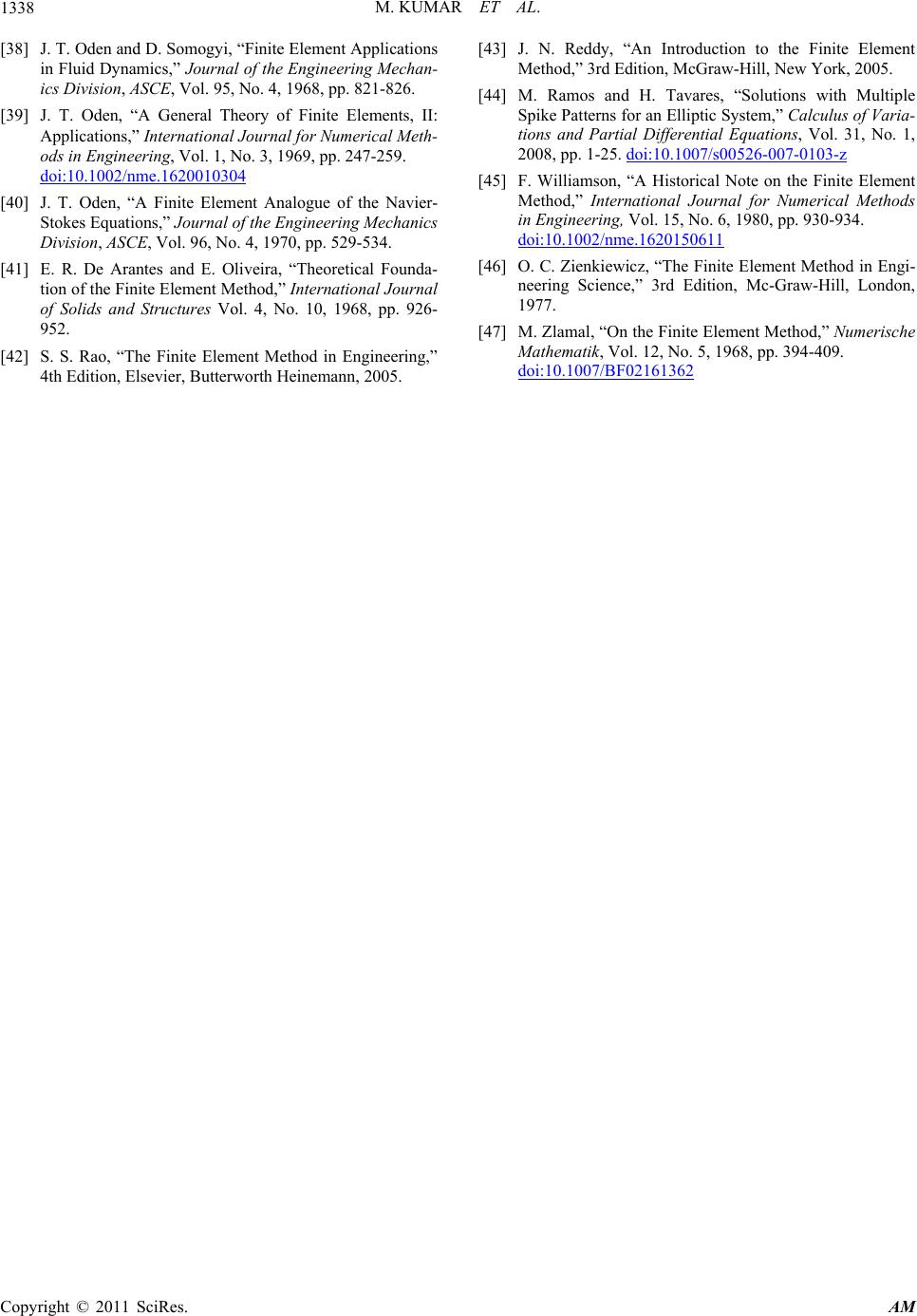 M. KUMAR ET AL. Copyright © 2011 SciRes. AM 1338 eering Mechan- , 1968, pp. 821-826. . 247-259. [38] J. T. Oden and D. Somogyi, “Finite Element Applications in Fluid Dynamics,” Journal of the Engin ics Division, ASCE, Vol. 95, No. 4 [39] J. T. Oden, “A General Theory of Finite Elements, II: Applications,” International Journal for Numerical Meth- ods in Engineering, Vol. 1, No. 3, 1969, pp doi:10.1002/nme.1620010304 [40] J. T. Oden, “A Finite Element Analogue of the Navier- Stokes Equations,” Journal of the Engineering Mechanics 2008 Division, ASCE, Vol. 96, No. 4, 1970, pp. 529-534. [41] E. R. De Arantes and E. Oliveira, “Theoretical Founda- tion of the Finite Element Method,” International Journ of Solids and Structures Vol. al 4, No. 10, 1968, pp. 926- eddy, “An Introduction to the Finite Element le 952. [42] S. S. Rao, “The Finite Element Method in Engineering,” 4th Edition, Elsevier, Butterworth Heinemann, 2005. [43] J. N. R Method,” 3rd Edition, McGraw-Hill, New York, 2005. [44] M. Ramos and H. Tavares, “Solutions with Multip Spike Patterns for an Elliptic System,” Calculus of Varia- tions and Partial Differential Equations, Vol. 31, No. 1, , pp. 1-25. doi:10.1007/s00526-007-0103-z [45] F. Williamson, “A Historical Note on the Finite Element Method,” International Journal for Numerical Methods in Engineering, Vol. 15, No. 6, 1980, pp. 930-934. doi:10.1002/nme.1620150611 [46] O. C. Zienkiewicz, “The Finite Element Method in Engi- neering Science,” 3rd Edition, Mc-Graw-Hill, London, 1977. [47] M. Zlamal, “On the Finite Element Method,” Numerische Mathematik, Vol. 12, No. 5, 1968, pp. 394-409. doi:10.1007/BF02161362
|